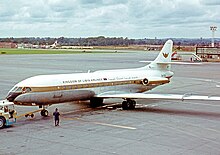Libyan Airlines
Following the carrier starting services along the Tripoli–Benghazi run, the Libyans prevented foreign companies that also flew the route from operating there in order to allow the national airline to expand.[6] Absorbing Libavia and United Libya Airlines operations,[7] international flights radiating from Benghazi and Tripoli began in October 1965 (1965-10), initially serving Athens, Cairo, London, Malta, Paris, Rome and Tunis.[8] The early years saw Air France providing the company with technical assistance, KLM managing the sales and reservations, and BOAC taking care of traffic, finance and communications.[19] The airline had 1,800 employees at April 1977 (1977-04); at this time, passenger and cargo flights radiating from Benghazi, Tripoli and Sebha to Athens, Algiers, Beirut, Cairo, Casablanca, Damascus, Jeddah, Khartoum, London, Malta, Paris, Rome, Tunis and Zürich were operated.[25] By mid-1980, the number of employees had grown to 2,500, and Amman, Belgrade, Cotonou, Istanbul and Niamey were added to the route network;[26] later that year, Karachi was incorporated as a destination.[28] At that time, Airbuses were equipped either with General Electric (GE) or Pratt & Whitney (P&W) powerplants, but the airline ordered Rolls-Royce engines to power them—something that had not been done before, as the former two were manufactured in the United States and there was a ban in force on providing Libya with technology that could possibly have military uses.[31] The company had managed to buy a number of ageing US-manufactured jets, including Boeing 707s and Douglas DC-8s, since 1979; many of them were either cannibalised for spare parts or sold.Employment at this time was 4,500; destinations served included Algiers, Amman, Amsterdam, Athens, Belgrade, Benghazi, Bucharest, Casablanca, Damascus, Frankfurt, Istanbul, Jeddah, Karachi, Kuwait, Larnaca, London, Madrid, Malta, Milan, Moscow, Paris, Rome, Sebha, Sfax, Sofia, Tripoli, Tunis, Vienna, Warsaw and Zürich, along with an extensive domestic network.[25] During the year, Libyan Arab managed to bypass the US economic embargo against the country when the carrier acquired, through intermediary companies,[31][34] ex-British Caledonian GE-powered A310 aircraft for US$105 million.[citation needed] Fleet and route network grew further when regional carrier Air Jamahiriya was merged into Libyan Arab Airlines in 2001.Newly introduced destinations like Milan, Ankara,[57] Athens[58] and Madrid have led to a route network similar to the one offered prior to the 1992 trade embargo.[61] In April 2012 (2012-04), Libyan Airlines was affected by a ban that was imposed by the European Union (EU) on all carriers having an operator's certificate issued in Libya from flying into the member countries.[78] On 21 September 2010, it was announced that the two airlines, which had already begun extensive code-sharing and set up joint ground handling, maintenance and catering services, were to merge by November of that year, which was later postponed indefinitely, though.Both airlines are to merge by the first half of 2013, according to Libya's current Interim Transport Minister Yousef el-Uheshi – 12 to 13 months after negotiations are expected to resume in March 2012.










List of airlines of LibyaTripoli International AirportBenina International AirportTripoliflag carrierEuropeNorth AfricaMiddle EastBenghazigovernment of LibyaSud CaravelleLondon GatwickSud SE-210 Caravellenational airlineUnited Libya AirlinesAthensLondonAir FranceFokker F27jet aircraftpropellerFokkerBoeing 727TridentSud Aviation CaravelleGeneva International AirportBeirutGenevaBoeing 727-200sCaravellesFokker F27sFalcon 20sBoeing 707-320CAlgiersCasablancaDamascusJeddahKhartoumZürichFrankfurtBoeing 727-200 AdvancedLondon Heathrow AirportLibyan Arab Airlines Flight 1103US State DepartmentBoeing 747sIdi AminUgandaLibyan Arab Air CargoMadridMoscowWarsawBelgradeCotonouIstanbulNiameyKarachiFokker F27-600sGeneral ElectricPratt & WhitneyRolls-RoyceenginesMystère/Falcon 20CEuroairportBoeing 707sDouglas DC-8sspare partsFokker F28-4000sBucharestKuwaitLarnacaViennaembargoBritish CaledonianAir AlgérieAlgerianSwissairSovietTupolev Tu-154MsLockheed L-100-200sIlyushin Il-76sTwin OttersUnited Nations Security Council Resolution 748Pan Am Flight 103UTA Flight 772Lockerbie bombingletter of intentAirbus A320sAir Djiboutiwet-leaseTransAerAir JamahiriyaAnkaraTunisianregisteredAirbus A320-200Manchester AirportNouvelairLibyan Civil Warresulting no-fly zoneUnited Nations Security Council Resolution 1973European Unionoperator's certificatelist of air carriers banned in the EUwet-leasedLibyan Civil Aviation Authoritylist of airlines banned in the EUAfriqiyah Airwayscode-sharingground handlingprivatisationArab SpringAirbus A330-200Istanbul Atatürk AirportParis Air Showmemorandum of understandingAirbusAirbus A350-800sAirbus A330-200sBombardier CRJ-900sCRJ-900sAirbus A330A350-8002014 Libyan conflictclashes between antagonistic forcesCRJ-900Airbus A350-900